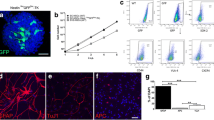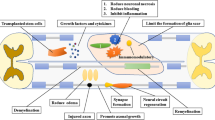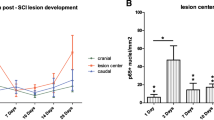Abstract
The importance of stem cells to ameliorate the devastating consequences of traumatic injuries in the adult mammalian central nervous system calls for improvements in the capacity of these cells to cope, in particular, with the host response to the injury. We have previously shown, however, that in the acutely traumatized spinal cord local energy metabolism led to decreased ATP levels after neural stem cell (NSC) transplantation. As this might counteract NSC-mediated regenerative processes, we investigated if NSC selected for increased oxidative stress resistance are better suited to preserve local energy content. For this purpose, we exposed wild-type (WT) NSC to hydrogen peroxide prior to transplantation. We demonstrate here that transplantation of WT-NSC into a complete spinal cord compression injury model even lowers the ATP content beyond the level detected in spinal cord injury–control animals. Compared to WT-NSC, stress-resistant (SR) NSC did not lead to a further decrease in ATP content. These differences between WT- and SR-NSC were observed 4 h after the lesion with subsequent transplantation. At 24 h after lesioning, these differences were no more as obvious. Thus, in contrast to native NSC, transplantation of NSC selected for oxidative stress resistance can positively influence local energy metabolism in the first hours after spinal cord compression. The functional relevance of this observation has to be tested in further experiments.




Similar content being viewed by others
References
Ader M, Meng J, Schachner M, Bartsch U (2000) Formation of myelin after transplantation of neural precursor cells into the retina of young postnatal mice. Glia 30:301–310
Ader M, Schachner M, Bartsch U (2004) Integration and differentiation of neural stem cells after transplantation into the dysmyelinated central nervous system of adult mice. Eur J Neurosci 20:1205–1210
Anderson DK, Means ED, Waters TR, Spears CJ (1980) Spinal cord energy metabolism following compression trauma to the feline spinal cord. J Neurosurg 53:375–380
Arien-Zakay H, Lecht S, Bercu MM et al (2009) Neuroprotection by cord blood neural progenitors involves antioxidants, neurotrophic and angiogenic factors. Exp Neurol 216:83–94
Barnabe-Heider F, Frisen J (2008) Stem cells for spinal cord repair. Cell Stem Cell 3:16–24
Brown AM, Ransom BR (2007) Astrocyte glycogen and brain energy metabolism. Glia 55:1263–1271
Brustle O, McKay RD (1996) Neuronal progenitors as tools for cell replacement in the nervous system. Curr Opin Neurobiol 6:688–695
Chen J, Bernreuther C, Dihne M, Schachner M (2005) Cell adhesion molecule l1-transfected embryonic stem cells with enhanced survival support regrowth of corticospinal tract axons in mice after spinal cord injury. J Neurotrauma 22:896–906
Coutts M, Keirstead HS (2008) Stem cells for the treatment of spinal cord injury. Exp Neurol 209:368–377
Curtis R, Green D, Lindsay RM, Wilkin GP (1993) Up-regulation of GAP-43 and growth of axons in rat spinal cord after compression injury. J Neurocytol 22:51–64
Darsalia V, Allison SJ, Cusulin C et al. (2011) Cell number and timing of transplantation determine survival of human neural stem cell grafts in stroke-damaged rat brain. J Cereb Blood Flow Metab 31:235–242
Dihne M, Bernreuther C, Sibbe M, Paulus W, Schachner M (2003) A new role for the cell adhesion molecule L1 in neural precursor cell proliferation, differentiation, and transmitter-specific subtype generation. J Neurosci 23:6638–6650
Genovese T, Cuzzocrea S (2008) Role of free radicals and poly(ADP-ribose)polymerase-1 in the development of spinal cord injury: new potential therapeutic targets. Curr Med Chem 15:477–487
Johann V, Schiefer J, Sass C et al (2007) Time of transplantation and cell preparation determine neural stem cell survival in a mouse model of Huntington's disease. Exp Brain Res 177:458–470
Lin HJ, Wang X, Shaffer KM, Sasaki CY, Ma W (2004) Characterization of H2O2-induced acute apoptosis in cultured neural stem/progenitor cells. FEBS Lett 570:102–106
Madhavan L, Ourednik V, Ourednik J (2008) Neural stem/progenitor cells initiate the formation of cellular networks that provide neuroprotection by growth factor-modulated antioxidant expression. Stem Cells 26:254–265
Mautes AEM, Schröck H, Nacimiento AC, Paschen W (2000) Regional spinal cord blood flow and energy metabolism in rats after laminectomy and acute compression injury. Eur J Trauma 26:122–130
Mautes AE, Thome D, Steudel WI, Nacimiento AC, Yang Y, Shohami E (2001) Changes in regional energy metabolism after closed head injury in the rat. J Mol Neurosci 16:33–39
Mautes AE, Liu J, Brandewiede J, Manville J, Snyder E, Schachner M (2004) Regional energy metabolism following short-term neural stem cell transplantation into the injured spinal cord. J Mol Neurosci 24:227–236
Ourednik J, Ourednik V, Lynch WP, Schachner M, Snyder EY (2002) Neural stem cells display an inherent mechanism for rescuing dysfunctional neurons. Nat Biotechnol 20:1103–1110
Park KI, Liu S, Flax JD, Nissim S, Stieg PE, Snyder EY (1999) Transplantation of neural progenitor and stem cells: developmental insights may suggest new therapies for spinal cord and other CNS dysfunction. J Neurotrauma 16:675–687
Paschen W (1990) Imaging of energy metabolites (ATP, glucose and lactate) in tissue sections: a bioluminescent technique. Prog Histochem Cytochem 20:1–122
Paschen W, Djuricic BM, Bosma HJ, Hossmann KA (1983) Biochemical changes during graded brain ischemia in gerbils. Part 2. Regional evaluation of cerebral blood flow and brain metabolites. J Neurol Sci 58:37–44
Ponten U, Ratcheson RA, Salford LG, Siesjo BK (1973) Optimal freezing conditions for cerebral metabolites in rats. J Neurochem 21:1127–1138
Ransom BR, Fern R (1997) Does astrocytic glycogen benefit axon function and survival in CNS white matter during glucose deprivation? Glia 21:134–141
Romeis B, Böck P (1989) Romeis - Mikroskopische Technik. 17. Auflage, neubearbeitete Ausgabe, Urban & Fischer Verlag
Rosario CM, Yandava BD, Kosaras B, Zurakowski D, Sidman RL, Snyder EY (1997) Differentiation of engrafted multipotent neural progenitors towards replacement of missing granule neurons in meander tail cerebellum may help determine the locus of mutant gene action. Development 124:4213–4224
Sarnowska A, Braun H, Sauerzweig S, Reymann KG (2009) The neuroprotective effect of bone marrow stem cells is not dependent on direct cell contact with hypoxic injured tissue. Exp Neurol 215:317–327
Snyder EY, Taylor RM, Wolfe JH (1995) Neural progenitor cell engraftment corrects lysosomal storage throughout the MPS VII mouse brain. Nature 374:367–370
Snyder EY, Yoon C, Flax JD, Macklis JD (1997) Multipotent neural precursors can differentiate toward replacement of neurons undergoing targeted apoptotic degeneration in adult mouse neocortex. Proc Natl Acad Sci U S A 94:11663–11668
Steward O, Zheng B, Tessier-Lavigne M (2003) False resurrections: distinguishing regenerated from spared axons in the injured central nervous system. J Comp Neurol 459:1–8
Tarasenko YI, Gao J, Nie L et al (2007) Human fetal neural stem cells grafted into contusion-injured rat spinal cords improve behavior. J Neurosci Res 85:47–57
Tekkok SB, Ransom BR (2004) Anoxia effects on CNS function and survival: regional differences. Neurochem Res 29:2163–2169
Teng YD, Lavik EB, Qu X et al (2002) Functional recovery following traumatic spinal cord injury mediated by a unique polymer scaffold seeded with neural stem cells. Proc Natl Acad Sci U S A 99:3024–3029
Weiss S (1999) Pathways for neural stem cell biology and repair. Nat Biotechnol 17:850–851
Zhang Y, Hillered L, Olsson Y, Holtz A (1993) Time course of energy perturbation after compression trauma to the spinal cord: an experimental study in the rat using microdialysis. Surg Neurol 39:297–304
Zwart I, Hill AJ, Al-Allaf F et al (2009) Umbilical cord blood mesenchymal stromal cells are neuroprotective and promote regeneration in a rat optic tract model. Exp Neurol 216:439–448
Acknowledgments
The authors thank Peter Hidiroglu, Sigrid Welsch, and Sonja Hoffmann for technical assistance, and Jochem König for help with statistical evaluations. We are grateful to Axel Methner for critically reviewing the manuscript.
Disclosure Statement
The authors declare no competing financial interests.
Author information
Authors and Affiliations
Corresponding author
Additional information
K. Schwerdtfeger, A. E. M. Mautes, C. Bernreuther and M. Dihné contributed equally to this work.
Rights and permissions
About this article
Cite this article
Schwerdtfeger, K., Mautes, A.E.M., Bernreuther, C. et al. Stress-Resistant Neural Stem Cells Positively Influence Regional Energy Metabolism After Spinal Cord Injury in Mice. J Mol Neurosci 46, 401–409 (2012). https://doi.org/10.1007/s12031-011-9600-9
Received:
Accepted:
Published:
Issue Date:
DOI: https://doi.org/10.1007/s12031-011-9600-9




